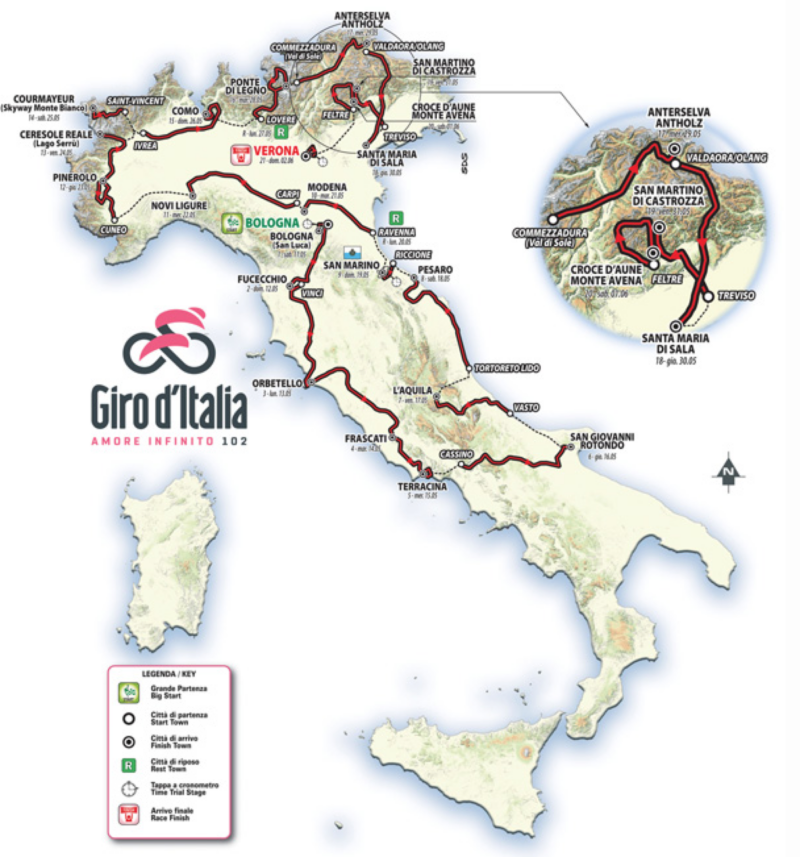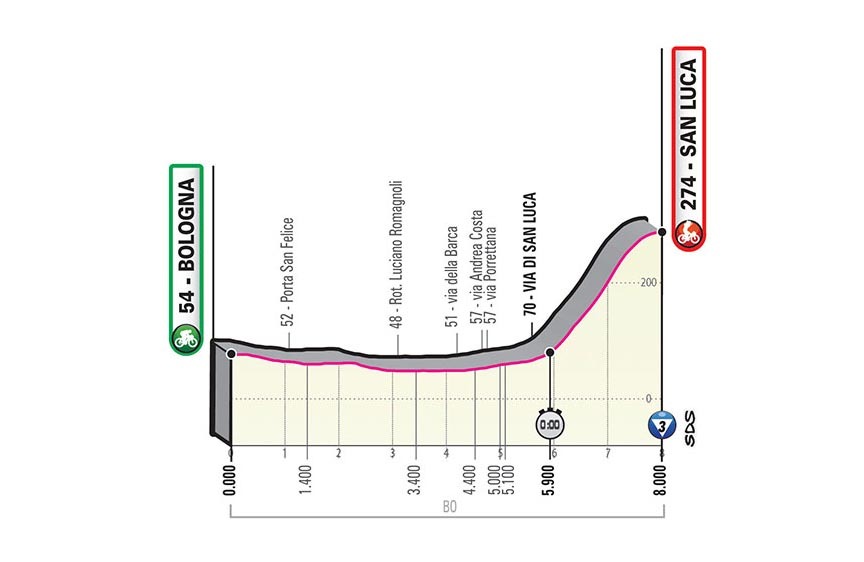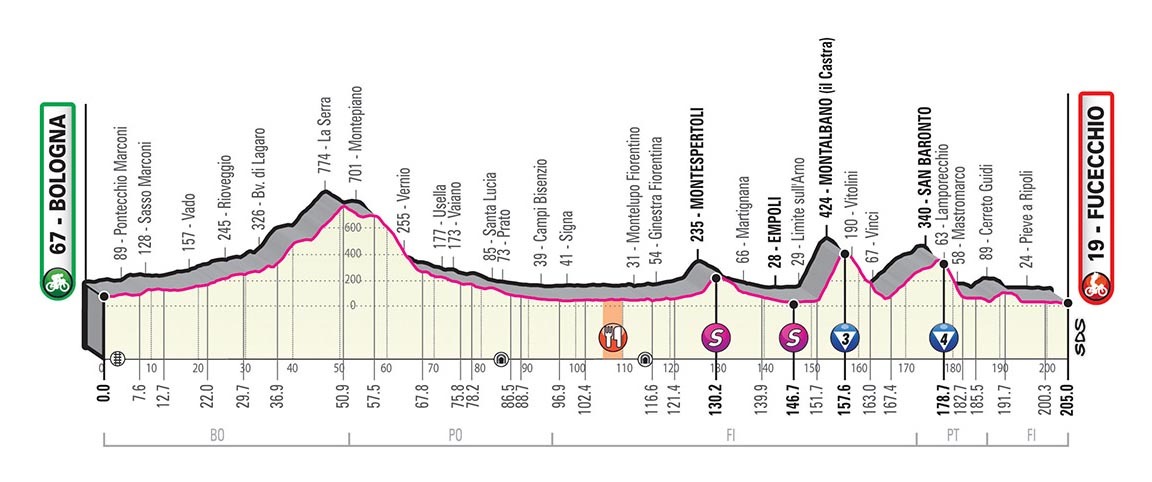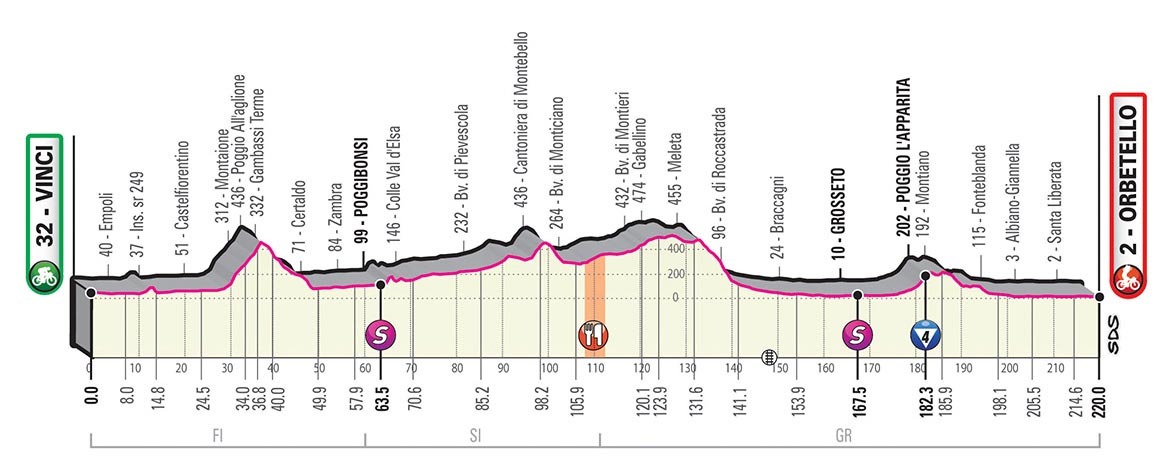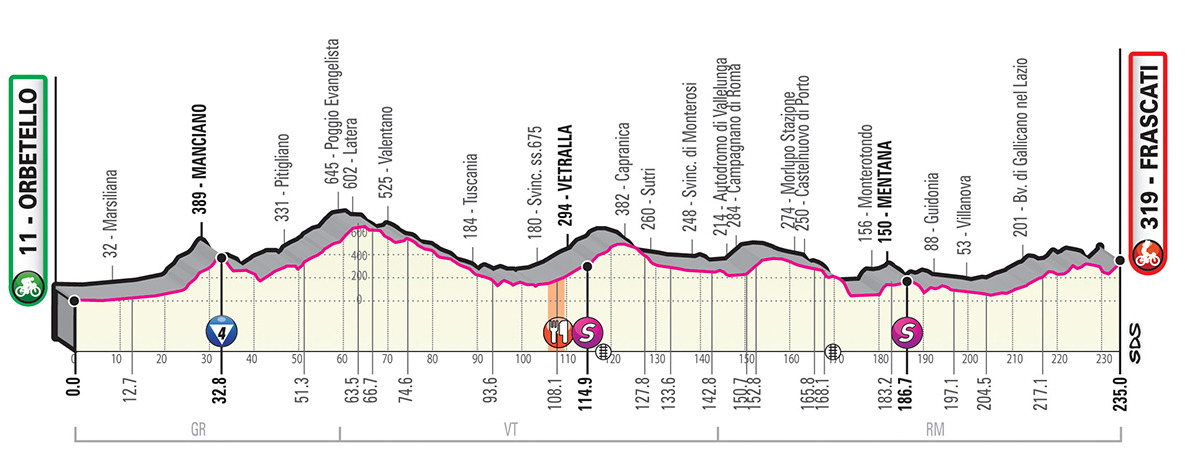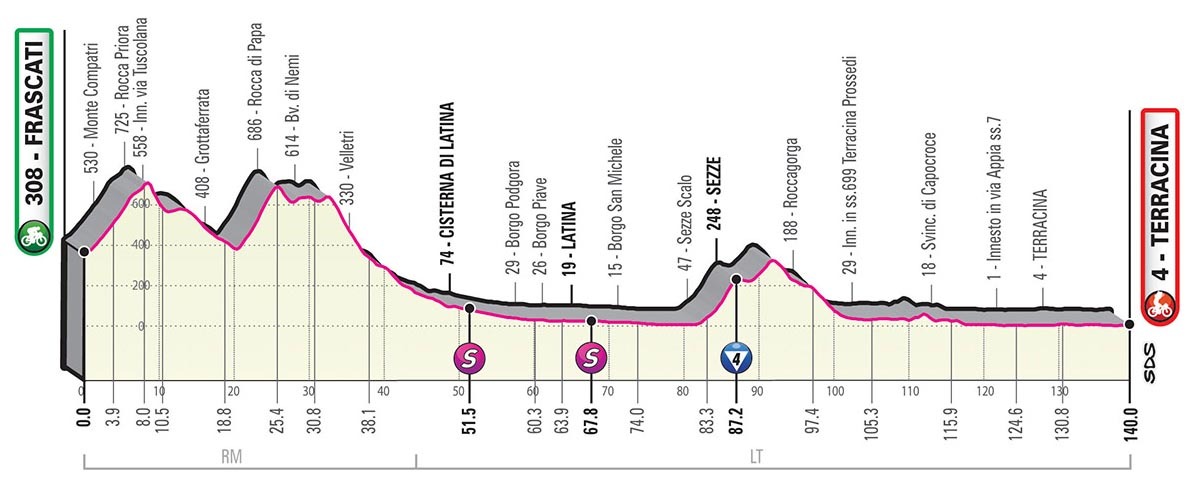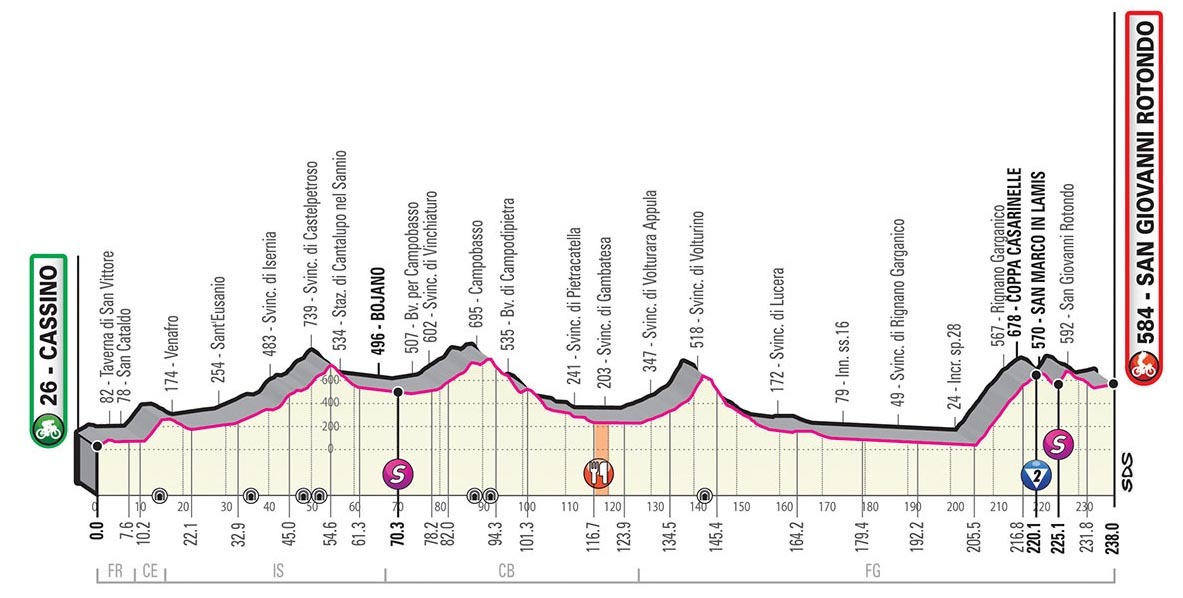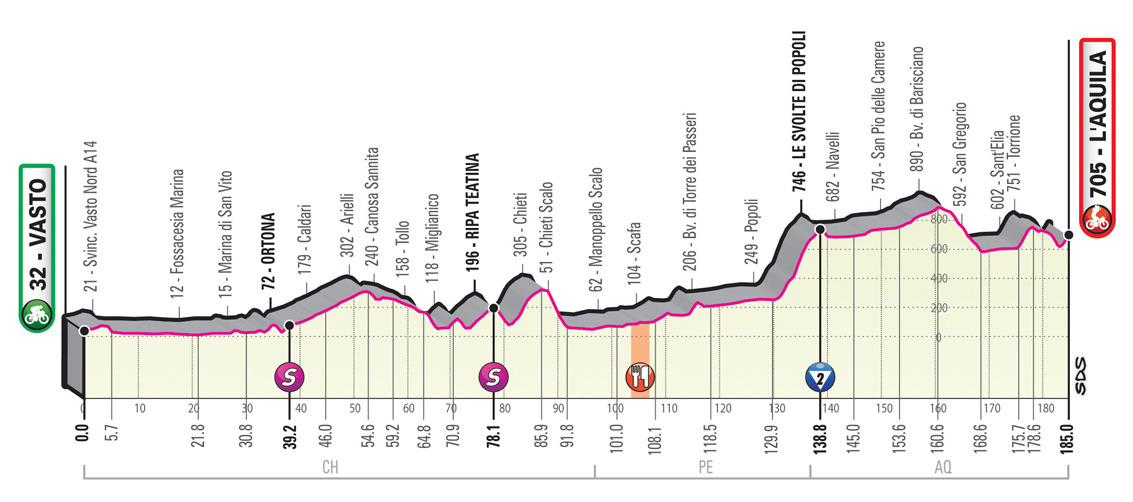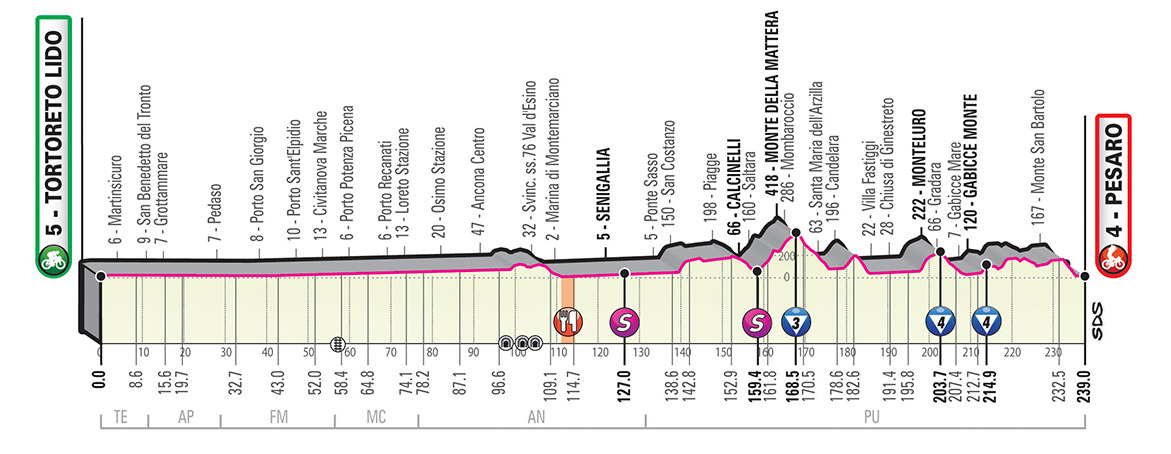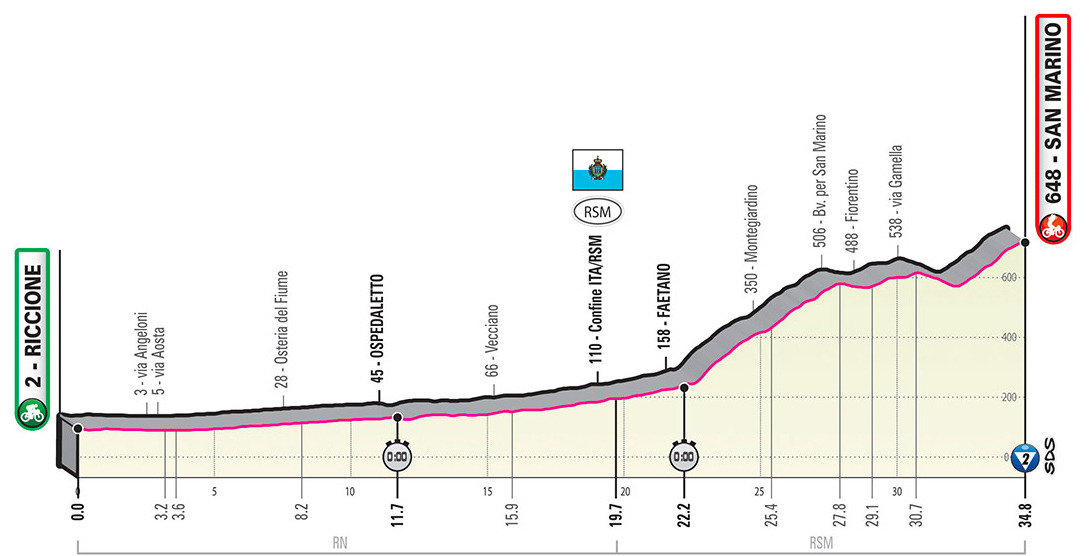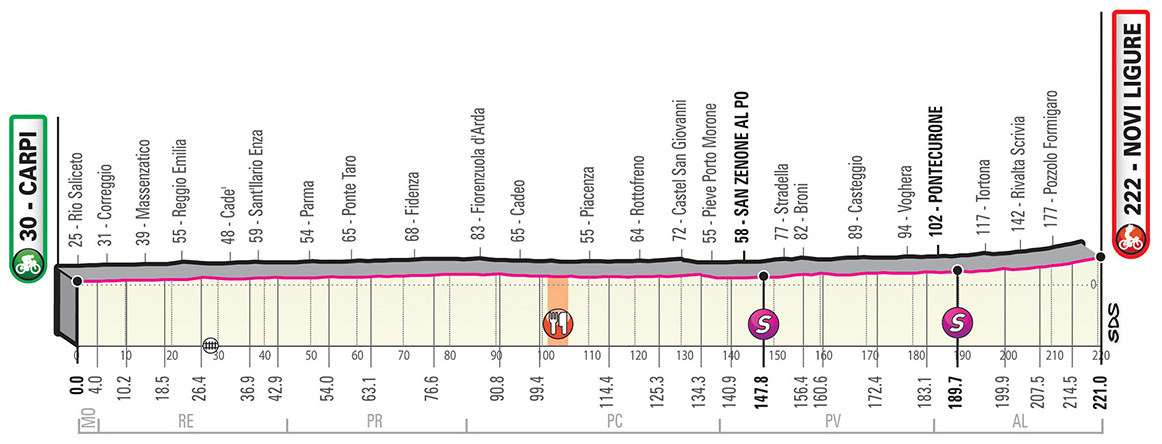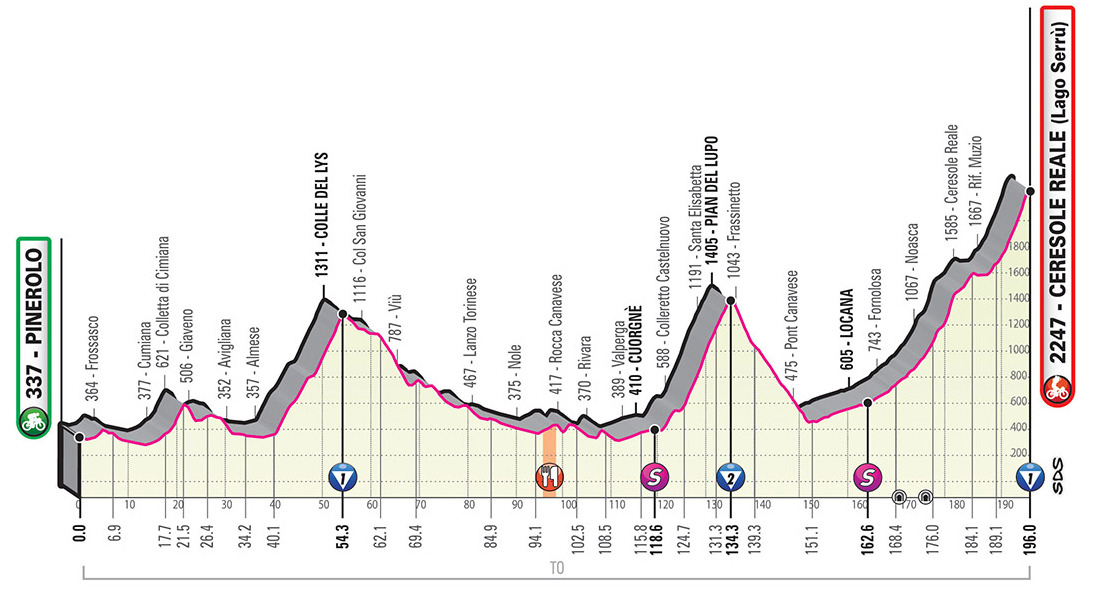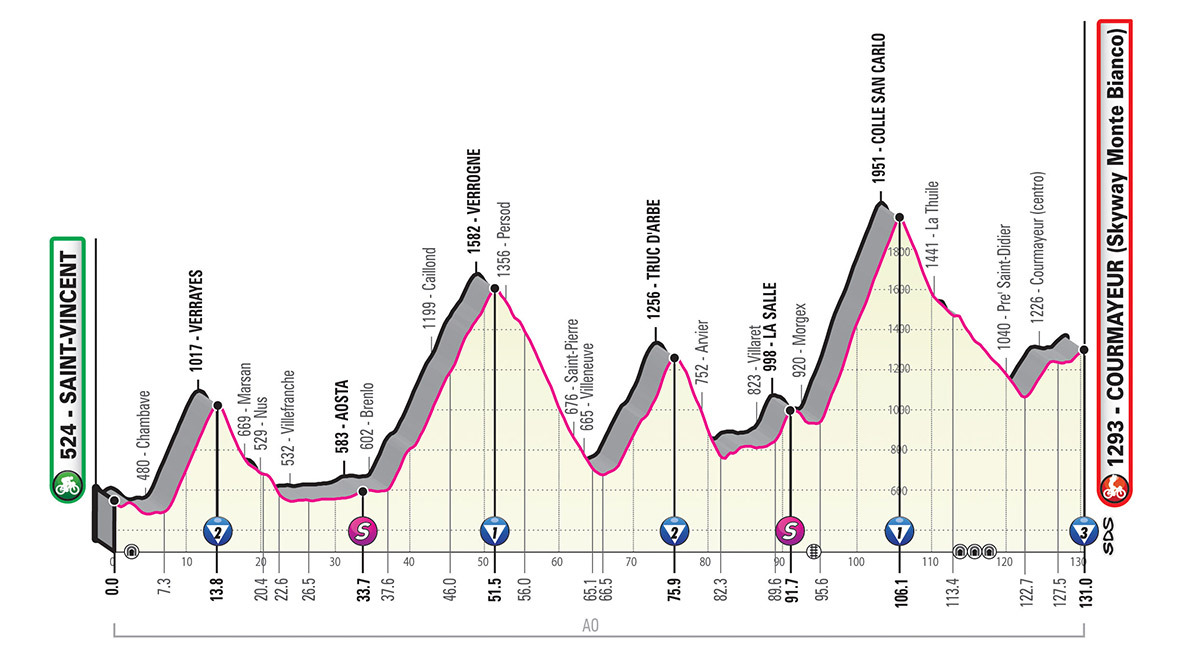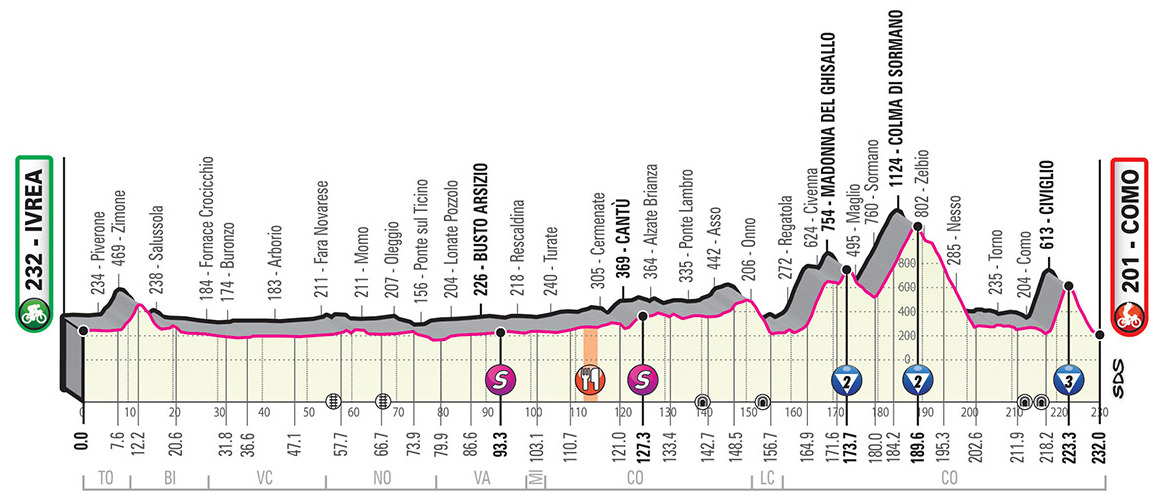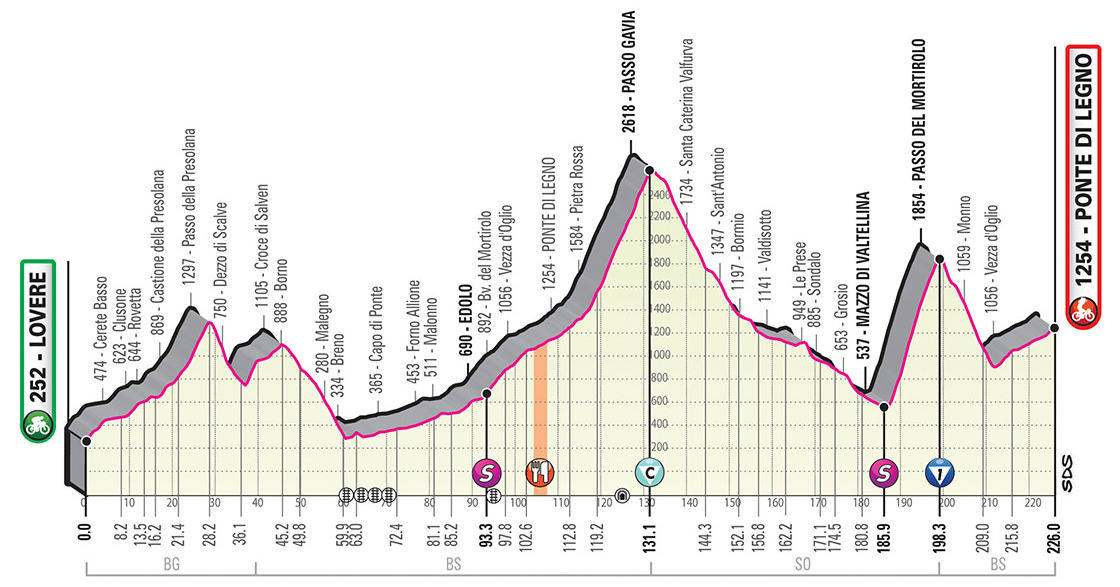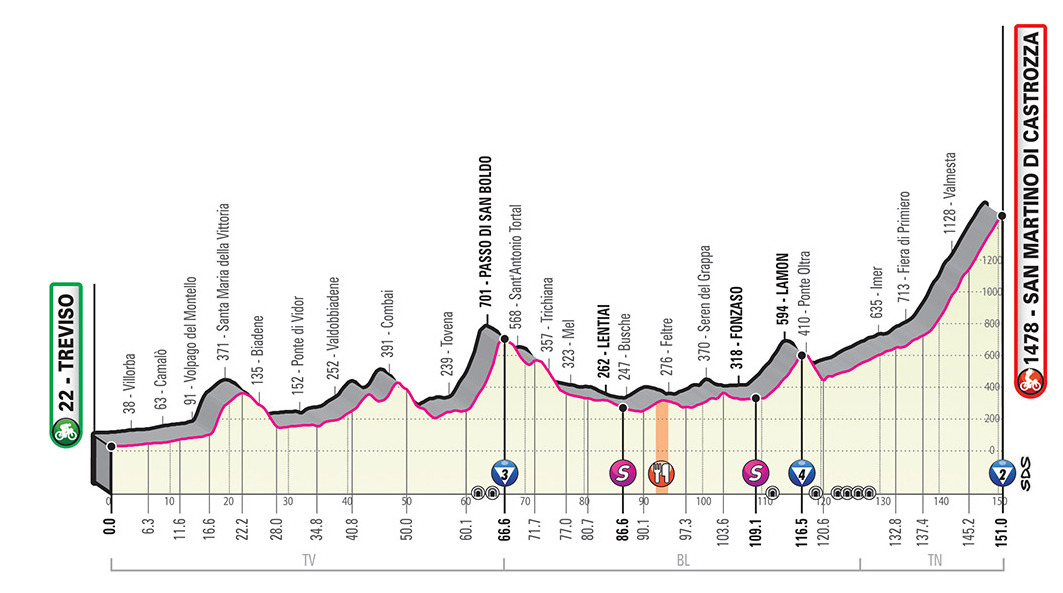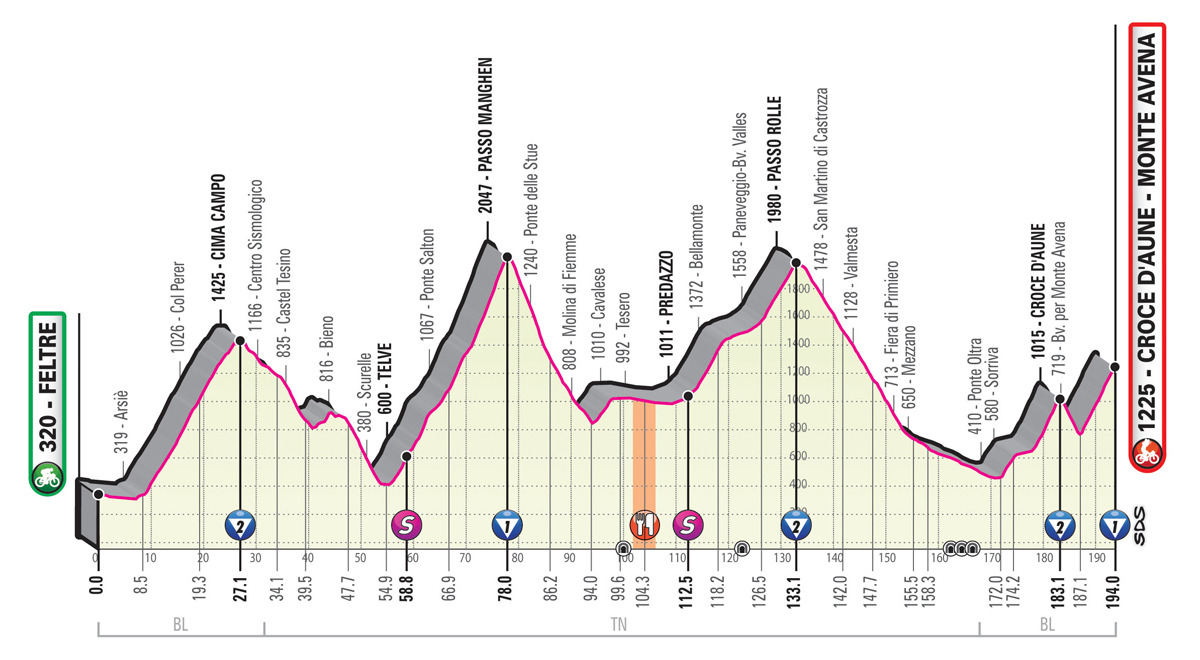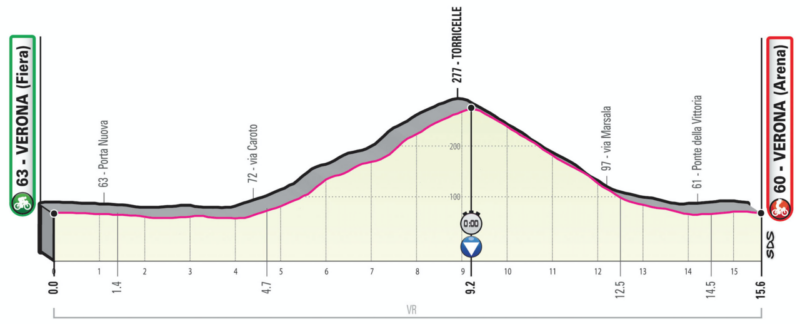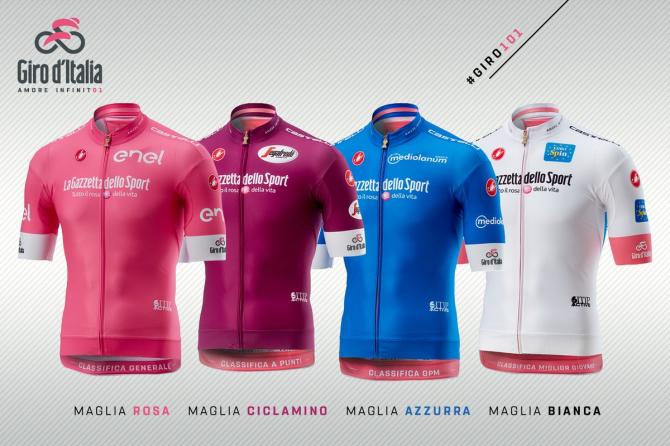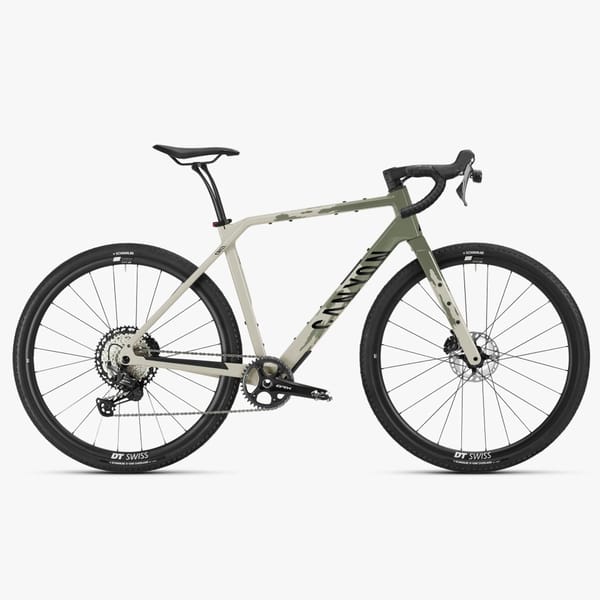Giro d'Italia 2019 Preview
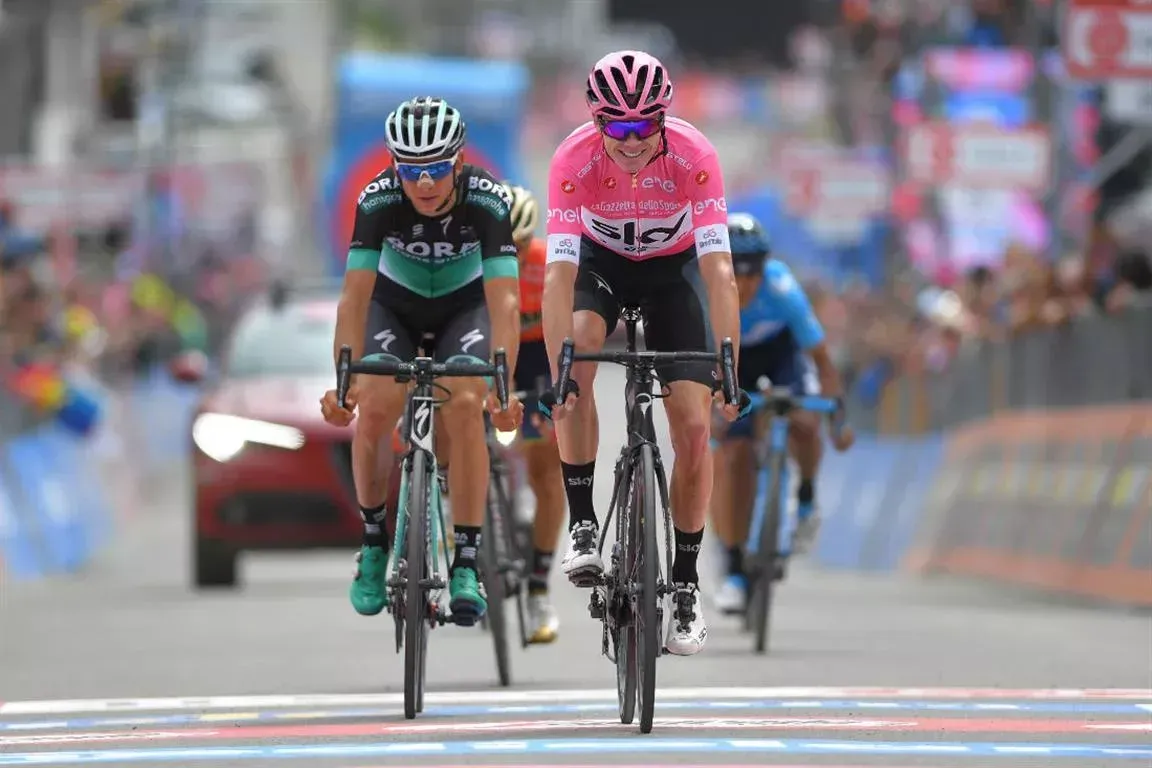
2019 Giro d’Italia Route
The Giro always saves the mountain stages for the last 7 to 10 days, but this years it seems to be even more pronounced. The opening stages will delight the sprinters with very little climbing until well into the second week. Then the second half will absolutely demolish the peloton with a lot of elevation change. There’s more climbing in this year’s Giro compared to the 2018 edition, but there are fewer summit finishes. Interestingly, most of the climbing comes mid-stage. There are three time trials (yellow stages above) with a total of 59.8km, more than any other race, so if you enjoy TTs this is the race for you. The TTs also each come with their fair share of climbing. Watch for an interesting battle between the GC guys and TT specialists.
Quick note before moving on to the individual stages: TV = Traguardo Volante or Intermediate Sprint and R = Rifornimento or Feed Zone.
Giro d’Italia Stage 1 (Prologue TT) – Saturday 11 May
The big send off. An 8km time trial with two very distinct parts. First riders will pass through a fast section of slightly downhill streets of Bologna. Then, pure pain sets in as they power up a hill climb to the San Luca basilica, a 1.8km ascent that averages 10.8% with sections at 16%. This will be a very telling test right off the bat.
Giro d’Italia Stage 2 – Sunday 12 May
Riders will cross the Apennines but despite some climbing this one will go to the sprinters. There will be some action for the climbers jersey though, if you can secure the jersey here you’re pretty much guaranteed to hold it for several days.
Giro d’Italia Stage 3 – Monday 13 May
A clear cut day for the sprinters.
Giro d’Italia Stage 4 – Tuesday 14 May
This is as close as the Giro will get to Rome. Not sure if it was last year’s treacherous rain covered flagstones, but it’s gone. The run in to the finish in Frascati is slightly up hill and the scenery is beautiful.
Giro d’Italia Stage 5 – Wednesday 15 May
A quick 140km day for the sprinters.
Giro d’Italia Stage 6 – Thursday 16 May
A much longer day in the saddle (238km). There is some climbing to the finish, 15km at a steady 4-5% to be exact, but not enough to steal this stage from the sprinters.
Giro d’Italia Stage 7 – Friday 17 May
The first half of stage 7 is along the coast before the race heads more inland. If you’re a motorsports fan you’ll likely recognize the Svolte de Popoli climb.
Giro d’Italia Stage 8 – Saturday 18 May
Another long mostly flat day (239km). There’s a chance that the small, punchy climbs towards the end of the day could shake things up.
Giro d’Italia Stage 9 – Sunday 19 May
Time trial day, 34.8km and with sustained climbing and a total of 900m of elevation gain. This will be a crucial stage for the overall contenders.
Giro d’Italia Stage 10 – Tuesday 21 May
It doesn’t get any flatter than this. Thankfully it’s just 145km. Sprinters will have no competition here.
Giro d’Italia Stage 11 – Wednesday 22 May
Another day for the sprinters. And it’s long.
Giro d’Italia Stage 12 – Thursday 23 May
A throwback stage celebrating Fausto Coppi’s 1949 incredible performance between these two towns. We’ll pretend to forget that it happened in the Alps. After approximately 90 km, the route enters the city to take a first pass of the “muro” (or wall) of via Principi di Acaja, and to crest the first category-one climb of the 2019 Giro. The race is new to this climb, which slopes at 9.4% for 8.9 km (with gradients exceeding 10% for over 6 km, and topping out at 14%). After a fast running descent, Pinerolo is 16 km away.
Giro d’Italia Stage 13 – Friday 24 May
The first summit finish. The stage is played out entirely within the province of Turin. The route circles the town from the north, cresting the Colle del Lys from the most challenging side, with long stretches sloping at 9-10%. After crossing the western Canavese, the race takes a first-ever climb up Pian del Lupo (along the Santa Elisabetta side). The climb and the descent are equally harsh and demanding, with two-figure gradients over long stretches. The final climb (more than 44 km overall, including the false-flat drag) begins at the end of the descent onto Pont Canavese. The climb officially starts in Noasca, touching the sharpest gradients. In the first part, the route covers the old road, properly repaved for bicycle transit, avoiding the long tunnel (3,650 m). The route flattens out in Ceresole, near the artificial lake, then rises again over the last 10 km.
Giro d’Italia Stage 14 – Saturday 25 May
The Giro borrows from the trend to short punchy climbing stages and I love it. Stage 14 is a short and very intense high mountain stage. The only flat stretch of the stage, 14 km out of 131, is around Aosta. Otherwise, the road goes either up or down. After the Verrayes categorised climb and after crossing Aosta, the route takes in consecutive climbs to Verrogne (15 km uphill and 15 km downhill), Combes (up to Truc d’Arbe, at the intersection to Arvier), Morgex (along panoramic roads) and Colle San Carlo. The route then drops sharply to La Thuile and Pré-Saint-Didier, where the old road eventually leads to Courmayeur.
Giro d’Italia Stage 15 – Sunday 26 May
A good day for the breakaway. The route covers 160 km on perfectly flat roads, passing through densely populated areas, with roundabouts, traffic dividers, pedestrian islands, setts paving and speed bumps being the main obstacles typically found in almost all urban areas. After crossing Cantù and Erba, the route reaches Pusiano and Asso, descends into Onno, and runs lakeside all the way to Bellagio, to the foot of the Ghisallo climb. The route climbs in hairpins on broad roadway, with maximum 14% gradients, then drops fast on long straight roads, as far as to Maglio. Here, the road turns left onto the Colma di Sormano. Past the Colma, the route drops to Nesso (starting with a false flat, followed by a technical descent with hairpins and narrowed roadway) and runs along the lakeshore, heading into Como. After a harsh climb to Civiglio, with steady 10% gradients (and a marked road narrowing at the top of the climb), the route drops down, crosses Como again and reaches the finish.
Giro d’Italia Stage 16 – Tuesday 28 May
A second gigantic Alpine stage, 226 km long, and with over 5,000 m vertical altitude gain. Starting uphill from Lovere to Rovetta, the route takes in climbs to Passo della Presolana and Passo della Croce di Salven, leading to Val Camonica. After reaching Edolo, the route turns towards Passo del Tonale and takes a first pass over the finish in Ponte di Legno. After cresting Passo Gavia (2618 m – Cima Coppi) along the “traditional” side, the route drops down into Bormio and further down to Mazzo (through the upper Valtellina), clearing the Mortirolo from the “conventional” side, with max. 18% gradients. After dropping into Monno, the route goes up again with shallow average gradients (3-4%) for the final 15 km, all the way to the finish.
Giro d’Italia Stage 17 – Wednesday 29 May
Another great day for the breakaway. The stage profile is wavy and twisting as it passes through several urban areas. The route starts downhill to the Val di Non, and takes an unprecedented climb to Passo della Mendola from the Fondo side (with steeper gradients). The course drops down into Bolzano and then climbs up the Eisack Valley, all the way to Bressanone. The riders will take in a succession of climbs and descents, with categorised summits in Elvas and Terento, leading to the foot of the final climb in Anterselva/Antholz.
Giro d’Italia Stage 18 – Thursday 30 May
Look at that profile. Essentially a rest day for the GC contenders and a last chance for the sprinters that remain.
Giro d’Italia Stage 19 – Friday 31 May
A short mountain stage with rolling undulations in the first part, as far as the Passo di San Boldo categorised climb. The closing ascent is short, yet punchy in the final kilometres, and the last 5 hairpins are inside a tunnel. The route then descends and levels out all the way to Feltre. After an uncomplicated cat. climb in Lamon, the stage travels across the Val Cismon (with a series of tunnels) as far as Fiera di Primiero, at the foot of the closing ascent.
Giro d’Italia Stage 20 – Saturday 1 June
A colossal stage through the Dolomites, with 5 long consecutive climbs alternating with milder or flat stretches. Setting off in Feltre, the stage encounters the first ascents in Arsiè. After cresting the Cima Campo climb (18 km), the route descends all the way to Castel Tesino and Scurelle. Next on the route, the ascent to Passo Manghen amounts to 24 km (including both the false flat and the actual climb), with nearly 2,000 m in vertical altitude gain. A fast-running descent leads through Molina di Fiemme, Cavalese, Tesero and Predazzo, all the way to Passo Rolle. The climb, although not forbidding, is over 20 km long, and precedes the final ascent to Croce d’Aune-Monte Avena. The final part, composed of two consecutive climbs, amounts to nearly 20 km. Over the last 6 km of the Croce d’Aune climb, gradients never drop below 10%, and even top out at 16%. The route descends briefly after Croce d’Aune, and then bounces back to sharp uphill gradients over the last 7 km.
Giro d’Italia Stage 21 – Sunday 2 June
Individual time trial on the Torricelle Circuit (the same as in the World Championships), covered counter-clockwise. The first part is on broad, straight boulevards, followed by an ascent sloping for 4.5 km at 5% in a series of steps, on narrower roadway. Split time is taken at the summit, where mountain points are up for grabs. The route then descends for 4 km, still on broad and straight roads. The last 3 km along the city streets, with some sharp bends, lead all the way to the finish in Piazza Bra and the Verona Arena.
The Giro d’Italia Jerseys
There are four jerseys in the Giro: pink, cyclamen, blue and white.
Pink: the maglia rosa, awarded to the rider with the best overall time for all the stages.
Worth mentioning time bonuses here, available on all stages but time trials:
- 10-6-4 seconds for the first three riders on each stage
- 3-2-1 seconds for the first three riders at the second intermediate sprint on each road stage
Cyclamen: the points competition. Here’s how points are awarded:
- Category A+B stages (Stages 3,4,5,10,11,18) offer points for the first 15 riders at the finish: 50-35-25-18-14-12-10-8-7-6-5-4-3-2-1. For the intermediate sprints there are points for the first eight: 20-12-8-6-4-3-2-1
- Category C stages: (Stages 2,6,7,8,12) offer points for the first 10: 25-18-12-8-6-5-4-3-2-1. First five for the sprints: 10-6-3-2-1
- Category D+E: (Stages 1,9,13,14,15,16,17,19,20,21) offer points for the first 10: 15-12-9-7-6-5-4-3-2-1. First three for the sprints: 8-4-1
Blue: the mountain jersey. Points are available at the top of the climbs. The scale has been adjusted in favor of first rider over the climbs for 2019.
There are five categories of climb:
- 10 fourth category climbs: the first three riders crossing the top of the climb win 3-2 and 1 points respectively
- 8 third category climbs: the first four riders over the top get 9-4-2-1 points
- 12 second category climbs: first six riders get 18-8-6-4-2-1 points
- 8 first category climbs: the first eight riders get 40-18-12-9-6-4-2-1 points
- CC or Cima Coppi: this year it is on the Passo Gavia on Stage 16. The first nine win 50-30-20-14-10-6-4-2-1 points
White: for the best young rider. Same deal as the maglia rosa except the rider must be born after 1 January 1994.
Who to Watch
Will strong time triallists such as Tom Dumoulin (Team Sunweb) and Primoz Roglic (Jumbo-Visma) control the race and take the victory in Verona? Or will the climbing prowess of Vincenzo Nibali (Bahrain-Merida) and Simon Yates (Mitchelton-Scott) (sadly Egan Bernal is out due to injury or I’d list him as well) prove to be decisive in the final week?
Chris Froome is eyeing a fifth Tour de France this year, so there will not be a repeat of his 2018 Giro d’Italia victory. However, Nibali is looking for his third victory and Dumoulin has been clear he wants a second win ahead of a shot at the Tour de France.
Nibali appeared to be in good form at the Tour of the Alps. Dumoulin has yet to win in 2019 but also looks strong, but the lack of a strong team around him could hurt in the mountains. Roglic has been very impressive so far this season, winning the UAE Tour and Tirreno-Adriatico, but three weeks racing is a whole different game. The same question applies to Simon Yates. He looked comfortable in the maglia rosa last year, then he lost his way mid time trial and never recovered.
Miguel Angel Lopez is my stealth pick. He won at Tour Colombia 2.1 race and again at the Volta a Catalunya. He’s got the form and he has one of the strongest teams (Astana) surrounding him.
How to Watch the 2019 Giro d’Italia
How to live stream the 2019 Giro d’Italia in the US
There are two official vendors for the 2019 Giro d’Italia live stream in the USA on Fubo.tv and Flobikes.
How to live stream the 2019 Giro d’Italia in the UK
UK residents can watch the Giro d’Italia on Eurosport 1 or with a Eurosport Player pass.
How to live stream the 2019 Giro d’Italia in Canada
Canadians can watch the Giro d’Italia 2019 on Fubo.tv and Flobikes.
How to live stream the 2019 Giro d’Italia in Australia
Australians can watch the 2019 Giro d’Italia on Eurosport or with a Eurosport Player pass.


